反意疑问句讲解
反意疑问句讲解_修改版
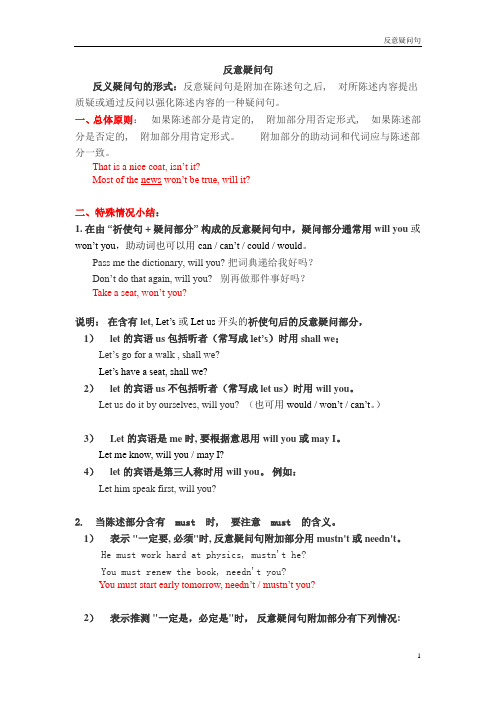
反意疑问句反义疑问句的形式:反意疑问句是附加在陈述句之后, 对所陈述内容提出质疑或通过反问以强化陈述内容的一种疑问句。
一、总体原则:如果陈述部分是肯定的, 附加部分用否定形式, 如果陈述部分是否定的, 附加部分用肯定形式。
附加部分的助动词和代词应与陈述部分一致。
That is a nice coat, isn’t it?Most of the news won’t be true, will it?二、特殊情况小结:1. 在由“祈使句 + 疑问部分”构成的反意疑问句中,疑问部分通常用will you或won’t you,助动词也可以用can / can’t / could / would。
Pass me the dictionary, will you? 把词典递给我好吗?Don’t do that again, will you?别再做那件事好吗?Take a seat, won’t you?说明:在含有let, Let’s或Let us开头的祈使句后的反意疑问部分,1)let的宾语us包括听者(常写成let’s)时用shall we;Let’s go for a walk , shall we?Let’s have a seat, shall we?2)let的宾语us不包括听者(常写成let us)时用will you。
Let us do it by ourselves, will you? (也可用would / won’t / can’t。
)3)Let的宾语是me时, 要根据意思用will you或may I。
Let me know, will you / may I?4)let的宾语是第三人称时用will you。
例如:Let him speak first, will you?2. 当陈述部分含有 must 时, 要注意 must 的含义。
1)表示 "一定要, 必须"时, 反意疑问句附加部分用 mustn't 或 needn't。
英语语法:反义疑问句专项讲解
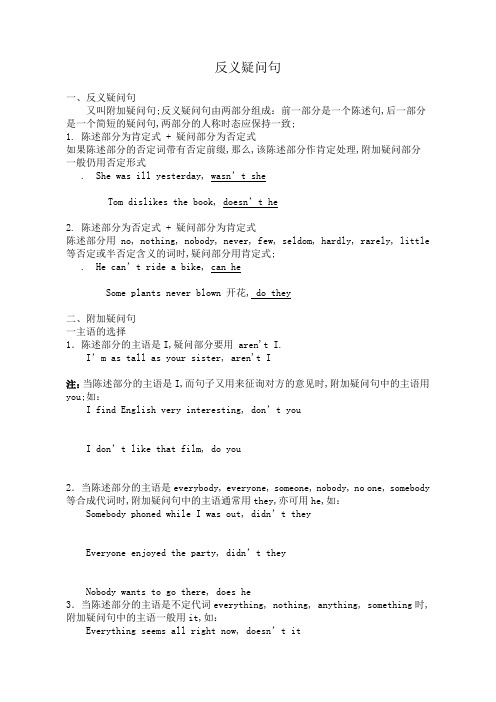
反义疑问句一、反义疑问句又叫附加疑问句;反义疑问句由两部分组成:前一部分是一个陈述句,后一部分是一个简短的疑问句,两部分的人称时态应保持一致;1.陈述部分为肯定式 + 疑问部分为否定式如果陈述部分的否定词带有否定前缀,那么,该陈述部分作肯定处理,附加疑问部分一般仍用否定形式. She was ill yesterday, wasn’t sheTom dislikes the book, doesn’t he2.陈述部分为否定式 + 疑问部分为肯定式陈述部分用 no, nothing, nobody, never, few, seldom, hardly, rarely, little 等否定或半否定含义的词时,疑问部分用肯定式;. He can’t ride a bike, can heSome plants never blown 开花, do they二、附加疑问句一主语的选择1.陈述部分的主语是I,疑问部分要用 aren't I.I’m as tall as your sister, aren't I注:当陈述部分的主语是I,而句子又用来征询对方的意见时,附加疑问句中的主语用you;如:I find English very interesting, don’t youI don’t like that film, do you2.当陈述部分的主语是everybody, everyone, someone, nobody, no one, somebody 等合成代词时,附加疑问句中的主语通常用they,亦可用he,如:Somebody phoned while I was out, didn’t theyEveryone enjoyed the party, didn’t theyNobody wants to go there, does he3.当陈述部分的主语是不定代词everything, nothing, anything, something时,附加疑问句中的主语一般用it,如:Everything seems all right now, doesn’t itNothing is kept in good order, is itSomething must be done to stop pollution, isn’t it4.当陈述部分的主语是指示代词this, that或these, those时,附加疑问句中的主语分别用it和they,如:This is important, isn’t itThat isn’t correct, is itThese are your friends Tom and Jack, aren’t they5.如果陈述部分是以代词one作主语,附加疑问句中的主语在正式场合用one,非正式场合下可以用you或he,如:One can’t be too careful, can one或can youOne should do his duty, shouldn’t he6.当陈述句为there be结构时,附加疑问句中的主语也用there;如:There’s no help for it, is thereThere’s something wrong, isn’t there7.当陈述部分为主从复合句时,附加疑问部分一般应与主句的主语和谓语动词保持对应关系;如:She says that I did it, doesn’t sheI told them not everybody could do it ,didn’t I但当陈述部分的主语是I,谓语是think, believe, suppose, expect这类动词时,附加疑问部分则往往与从句中的主语和谓语动词保持对应关系,但要注意否定的转移;I suppose that he’s serious isn’t heI don’t think she cares, does she8.当陈述部分是并列句,附加疑问句则需和就近的分句的主语和谓语一致;如:Xiao Lin has been writing letters all afternoon but he should finish them now, shouldn’t he9.在由“祈使句+附加疑问”构成的附加疑问句中,附加疑问部分的主语一般用you;如:Don’t open the door, will youGive me some cigarettes, can youTake a rest, why don’t you但以let’s开头的祈使句,附加疑问部分用shall we;以let us开头的祈使句,如果含义是allow us,不包括听话人在内,疑问部分用will you;如:Let’s have a basketball match this afternoon, shall weLet us go out for a rest, will you10.陈述句子中的主语为动词不定式短语、动名词短语或其他短语时,疑问部分的主语通常用it;如:Learning how to repair motors takes a long time, doesn’t itBetween six and seven will suit you, won’t itWhere to hold the meeting has not been decided, has it二谓语动词的选择1.当陈述部分带有情态动词must表示“必须”时,疑问部分用mustn’t;如:You must work hard next term, mustn’t youI must answer the letter, mustn’t I但若表推测这层含义时,不能用must,而要根据陈述部分的不定式结构即must之后的动词以及含义采用相应的动词形式;如:You must have made a mistake, haven’t youThey must have seen the film last week, didn’t theyHe must be in the library, isn’t he2.当陈述部分含有used to时,疑问部分可用usedn’t或didn’t;如:The old man used to smoke, didn’t /usedn’t heTom used to live here, usedn’t /didn’t he3.当陈述部分带有情态动词ought to时,疑问部分用oughtn’t或shouldn’t;如:He ought to know the answer, oughtn’t heWe ought to read this book, oughtn’t/ shouldn’t we4.当陈述部分含有情态动词dare或need时,疑问部分常用 need /dare +主语;We need not do it again, need weHe dare not say so, dare you但当dare, need 为实义动词时,疑问部分用助动词do + 主语;She doesn't dare to go home alone, does she5.当陈述部分含有had better时,疑问部分用hadn’t; 如:You’d better finish your homework now, hadn’t you6.感叹句后的附加疑问句的谓语动词需用be的现在时,且常用否定形式;如:What a clever boy, isn’t heWhat a lovely day, isn’t it7.陈述句中的谓语动词是wish,表示愿望时,附加疑问句用may,且用肯定形式;如:I wish to have a chance to learn English, may I8.当陈述部分带有表示“所有”含义的动词havehas时,疑问部分既可用have形式,也可用do形式;如:You have a new bike, haven’t you或don’t youShe doesn’t have any money in her pocket, does she9.陈述部分有have to +v. had to + v.,疑问部分常用don't +主语didn't +主语;如:We have to get there at eight tomorrow, don't we10.陈述部分有would rather +v.,疑问部分多用 wouldn't +主语;如:He would rather read it ten times than recite it, wouldn't he11.陈述部分有You'd like to +v. 疑问部分用wouldn't +主语;如:12.陈述部分由neither… nor, either… or 连接的并列主语时,疑问部分根据其实际逻辑意义而定;Neither you nor I am engineer, are we13.在口语和非正式文体中,为了加强语气,只是表示某种惊奇、怀疑、反感、讽刺等感情而并不是为了寻求回答,这时前后两部分的肯定、否定是一致的;如:Oh, he is a writer, is heYou’ll not go, won’t you三反义疑问句的回答对反意疑问句的回答,无论问题的提法如何,如果事实是肯定的,就用yes,事实是否定的,就要用no;例:—He likes playing football, doesn’t he 他喜欢踢足球,是吗—Yes, he does. / No, he doesn’t. 是的,他喜欢;/ 不是,他不喜欢;当陈述句部分是否定结构,附加疑问句部分用肯定式提问时,回答yes或no与汉语的意思正好相反;这种回答的yes要译成“不”,no要译成“是”;—His sister didn’t attend the meeting, did she 他妹妹没有参加会议,是吗—Yes, she did. / No, she didn’t. 不,她参加了;/ 是的,她没参加;反义疑问句练习1. Linda ate nothing this morning, ___A. didn’t sheB. was sheC. did sheD. wasn’t she2. There’s hardly___ milk in the bottle, _____thereA. no, isn’tB. some, isC. little, isn’tD. any, is3. He has never ridden a horse before, ___A. does heB. has heC. hasn’t heD. doesn’t he4. — He seldom came here, _____ — Yes sir.A. didn’t heB. does heC. doesn’t heD. did he5. Everything seems all right, _____A. does itB. don’t theyC. won’t itD. doesn’t itA. oneB. heC. itD. we8. No one failed in the exam, _____A. was heB. did oneC. did theyD. didn’t he10. Neither you nor I am a artist, _____A. am IB. aren’t weC. are weD. ain’t I11. He can’t be her father, _____ heA. isB. isn’tC. canD. can’t12. They have no time to visit the museum, _____A. do theyB. haven’t theyC. don’t theyD. will they14. You’d better go at once, _____ youA. hadn’tB. didC. didn’tD. don’t15. You’d rather work than play, _____ youA. hadn’tB. wouldn’tC. didn’tD. mustn’t16. You dare not do that, _____ youA. don’tB. doC. dareD.daren’t18. He dislikes the two subjects, _____ heA. doesB. doesn’tC. isD.isn’t19. These tools are useless now, _____A. are theyB. aren’t theyC. is itD. isn’t it20. He used to get up at 6:30, _____ heA. didn’t heB. did heC. used heD. wouldn’t heA. mustn’tB. oughtn’tC. shouldn’tD. Both B and C.23. Let’s go there by bus, ___A. will youB. shall weC. don’t youD. will you24. Let us go to play football, ___A. will youB. shall weC. do weD. are we25. Don’t forget to give Polly some food and change her water, ___A. will youB. shall weC. won’t youD. do you26. —Let’s go shopping this afternoon, _____ — All right.A. will weB. shall weC. don’t weD. are we27. — Pass me the dictionary, _____— Yes, with pleasure.A. would youB. will youC. won’t youD. wouldn’t you30. There is little water in the glass, ____A. isn’t thereB. isn’t itC. is itD. is there32. There won’t be any concert this Saturday evening, _____A. will there notB. will thereC. is thereD. won’t33. — I guess she taught herself Japanese, ______ — Yes.A. don’t IB. did sheC. do ID. didn’t she34. I don’t believe you are right, _____A. are youB. do youC. won’t youD. do35. She doesn’t think that Tom sings best in the class, _____A. does sheB. doesn’t sheC. does heD. doesn’t he37. I know you didn’t want to hurt me, _____A. did youB. didn’t youC. do ID. don’t I38. If my father were here, he would be very happy, _____A. weren’t heB. were heC. wouldn’t heD. would he。
反义疑问句详细讲解课件(PPT27张)
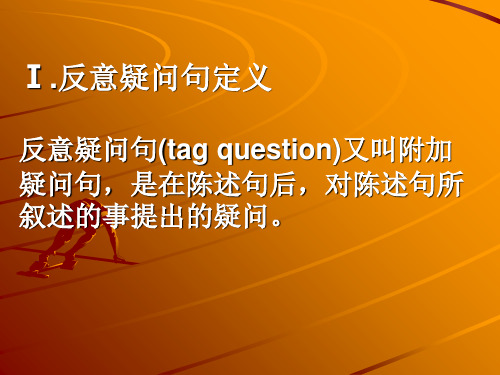
7.当陈述部分的主句是I think (expect, believe)等结构时,反 意疑问句的附加部分则往往与从 句中的主语和谓语动词保持对应 关系,但要注意否定的转移。 例如:
I think he’s funny, isn’t he? I don’t believe she likes my
You must have seen the film last week, didn’t you?
6. 当陈述部分是I am…时,反意疑 问句部分通常要用aren’t I;如陈述 句部分的主语是I am not时,反意疑 问句部分通常要用am I。 例如:
1)I am a teacher, aren’t I?
Ⅰ.反意疑问句定义
反意疑问句(tag question)又叫附加 疑问句,是在陈述句后,对陈述句所 叙述的事提出的疑问。
Ⅱ.基本结构:
陈述句+逗号+简短的一般疑问句?
遵循前肯定后否定前否后肯式的原则
①前肯后否式。例如:
You are all students, aren’t you﹖
②前否后肯式。例如:
Let’s have a rest, shall we? 以let us开头的祈使句,不包括 说话人在内,因此反意疑问句的 附加部分用will you。例如:
Let us stop now, will you?
Ⅳ. 反意疑问句的回答 “ 根据事实回答”
对反意疑问句的回答,无论问题的提法如何,如果 事实是肯定的,就用yes,事实是否定的,就要用no。 要特别注意陈述句部分是否定结构,反意疑问句部分 用肯定式提问时,回答yes或no与汉语正好相反。这 种省略回答的yes要译成“不”,no要译成“是”。
(完整)反义疑问句讲解和练习(答案)
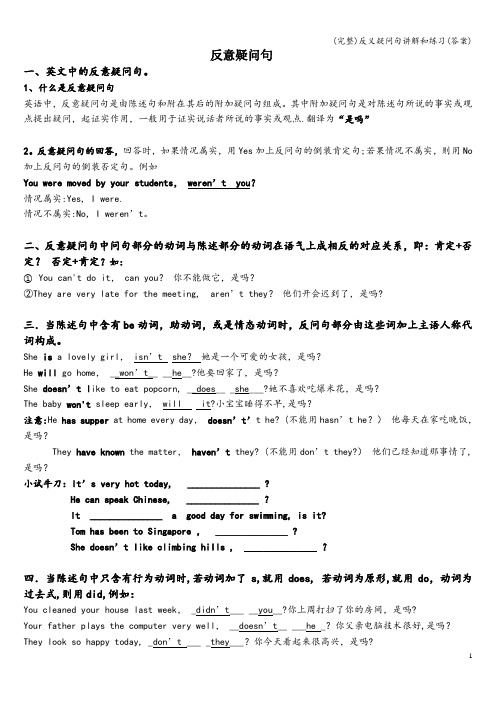
反意疑问句一、英文中的反意疑问句。
1、什么是反意疑问句英语中,反意疑问句是由陈述句和附在其后的附加疑问句组成。
其中附加疑问句是对陈述句所说的事实或观点提出疑问,起证实作用,一般用于证实说话者所说的事实或观点.翻译为“是吗”2。
反意疑问句的回答,回答时,如果情况属实,用Yes加上反问句的倒装肯定句;若果情况不属实,则用No 加上反问句的倒装否定句。
例如You were moved by your students,weren’t you?情况属实:Yes, I were.情况不属实:No, I weren’t。
二、反意疑问句中问句部分的动词与陈述部分的动词在语气上成相反的对应关系,即:肯定+否定?否定+肯定?如:①You can't do it, can you?你不能做它,是吗?②They are very late for the meeting, aren’t they?他们开会迟到了,是吗?三.当陈述句中含有be动词,助动词,或是情态动词时,反问句部分由这些词加上主语人称代词构成。
She is a lovely girl,isn’t she?她是一个可爱的女孩,是吗?He will go home, __won’t__ __he__?他要回家了,是吗?She doesn’t l ike to eat popcorn, __does__ _she___?她不喜欢吃爆米花,是吗?The baby won't sleep early, will it?小宝宝睡得不早,是吗?注意:He has supper at home every day,doesn’t’t he? (不能用hasn’t he?)他每天在家吃晚饭,是吗?They have known the matter,haven’t they? (不能用don’t they?)他们已经知道那事情了,是吗?小试牛刀:It’s very hot today, _______________ ?He can speak Chinese, _______________ ?It _______________ a good day for swimming, is it?Tom has been to Singapore , _______________ ?She do esn’t like climbing hills , _______________ ?四.当陈述句中只含有行为动词时,若动词加了s,就用does, 若动词为原形,就用do,动词为过去式,则用did,例如:You cleaned your house last week, _didn’t___ __you__?你上周打扫了你的房间,是吗?Your father plays the computer very well, __doesn’t__ ___he _?你父亲电脑技术很好,是吗?They look so happy today, _don’t ___ _they___?你今天看起来很高兴,是吗?小试牛刀: Meimei studies in a middle school, _______________ ?He loves cold weather , _______________ ?You finished the task yesterday, _______________ ?五.反意疑问句的陈述部分带有little, few, never, hardly, seldom,nobody, nothing,barely, scarcely等否定意义的词时,问句部分用肯定式.如:①She never tells a lie, does she?(不用doesn’t she?)她从不说谎,是吗?②He was seldom late, was he?(不用wasn’t he?) 他几乎不迟到,是吗?小试牛刀:Few students can answer the question, _______________ ?He can hardly finish his homework, _______________ ?六、反意疑问句的陈述部分为I am……时,问句部分习惯上用aren’t I?表示.如:I am a very honest man, aren’t I? 我是个很诚实的人,是吗?小试牛刀:I’m in Class 3,Grade 2, _______________ ?I’m ten years old, _______________ ?七.陈述部分的主语为不定代词something, anything, nothing, everything时,问句部分的主语用it。
(完整版)高考英语反意疑问句讲解及练习

反意疑问句一、见解反义疑问句 (The Disjunctive Question)即附加疑问句,反意疑问句是疑问句的一种,是对陈述句所说的事实或见解提出疑问,起证明作用,一般用于证实说话者所说的事实或见解。
反意疑问句是由陈述句和附在以后的附加疑问句组成。
结构有以下两种:1.陈述部分必定式 +疑问部分否定式2.陈述部分否定式 +疑问部分必定式即:前肯后否,前否后肯。
反义疑问部分用助动词或神情动词或be 动词+名词或代词(主格)。
如: They work hare, don’t they?She was ill yesterday, wasn’t she?You didn ’t go, did you?He can’t ride a bike, can he?二、反义疑问句的用法1. 陈述部分主语是I 的必定形式时,疑问部分要用aren ’t I.如: I ’m as tall as your sister,aren’t I?2.陈述部分含有否定词或半否定词,以及含有由否定意义的词的反意疑问句当陈述部分有 never ,seldom, hardly ,few,little ,barely, scarcely, nothing ,nobody 等否定词或半否定词时,反意疑问部分用必定形式。
否定前缀不能够视为否定词,其反意疑问句仍用否定形式。
如: There are few apples in the basket, are there?He can hardly swim, can he?They seldom come late, do they?It is impossible, isn't it?He is not unkind to his classmates, is he?3、含有宾语从句的反意疑问句当陈述部分是一个(带that引导宾语从句的)主从复合句时,附加疑问句的主谓要和主句的主谓保持对应关系。
反义疑问句超详细讲解!!!
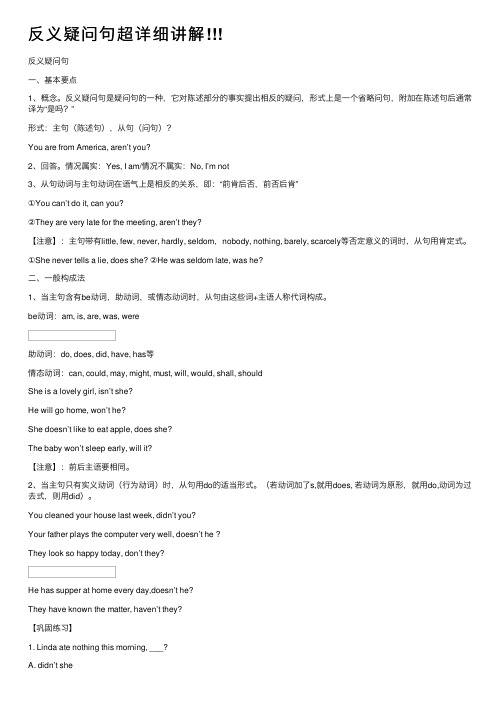
反义疑问句超详细讲解反义疑问句⼀、基本要点1、概念。
反义疑问句是疑问句的⼀种,它对陈述部分的事实提出相反的疑问,形式上是⼀个省略问句,附加在陈述句后通常译为“是吗?”形式:主句(陈述句),从句(问句)?You are from America, aren’t you?2、回答。
情况属实:Yes, I am/情况不属实:No, I’m not3、从句动词与主句动词在语⽓上是相反的关系,即:“前肯后否,前否后肯”①You can’t do it, can you?②They are very late for the meeting, aren’t they?【注意】:主句带有little, few, never, hardly, seldom,nobody, nothing, barely, scarcely等否定意义的词时,从句⽤肯定式。
①She never tells a lie, does she? ②He was seldom late, was he?⼆、⼀般构成法1、当主句含有be动词,助动词,或情态动词时,从句由这些词+主语⼈称代词构成。
be动词:am, is, are, was, were助动词:do, does, did, have, has等情态动词:can, could, may, might, must, will, would, shall, shouldShe is a lovely girl, isn’t she?He will go home, won’t he?She doesn’t like to eat apple, does she?The baby won’t sleep early, will it?【注意】:前后主语要相同。
2、当主句只有实义动词(⾏为动词)时,从句⽤do的适当形式。
(若动词加了s,就⽤does, 若动词为原形,就⽤do,动词为过去式,则⽤did)。
反义疑问句(最全)知识讲解
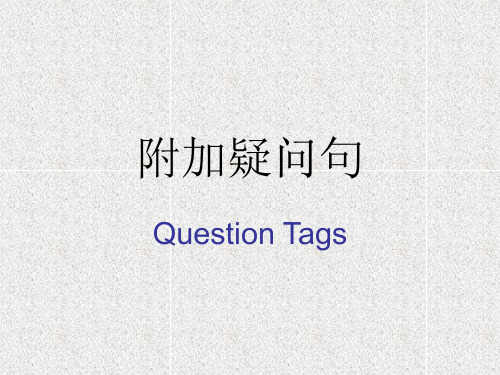
四、有情态动词的反义疑问句:
1.带情态动词dare或need的反意疑问句,疑问部分常 用 need (dare ) +主语。 We need not do it again, need we ? He dare not say so, dare he? 当dare, need 为实义动词时,疑问部分用助动词do + 主语。
D.must表示推测 ,其疑问部分必须与must 后面的主要 动词相呼应 ①对现在动作或存在的情况的推测(don’t +主语) You must know the answer to the exercise, don’t you? ②对过去发生的动作或存在的情况的推测有两种情况:
a 表示肯定推测 (一)句中陈述部分没有表示过去的时间状语,这时疑问 部分中的动词就用现在完成时。 (haven’t / hasn’t + 主语) You must have told her about it, haven’t you?
5.陈述部分有would rather +v.,疑问部分多用 wouldn’t +主语。 He would rather read it ten times than recite it,
wouldn’t he? 6.陈述部分有you’d like to +v. 疑问部分用wouldn’t + 主语。
三、一些特殊结构的反义疑问句:
1.含有ought to 的反意疑问句,陈述部分是肯定的,疑 问部分用shouldn’t / oughtn’t +主语。 He ought to know what to do, oughtn’t he? / shouldn’t he? 2.陈述部分有have to +v. (had to + v.),疑问部分常用 don’t +主语(didn’t +主语)。 We have to get there at eight tomorrow, don’t we? 3.陈述部分的谓语是used to 时,疑问部分用didn’t +主 语或 usedn’t +主语。 He used to take pictures there, didn’t he? / usedn’t he? 4.陈述部分有had better + v. 疑问句部分用hadn’t you? You’d better read it by yourself, hadn’t you?
反义疑问句的讲解
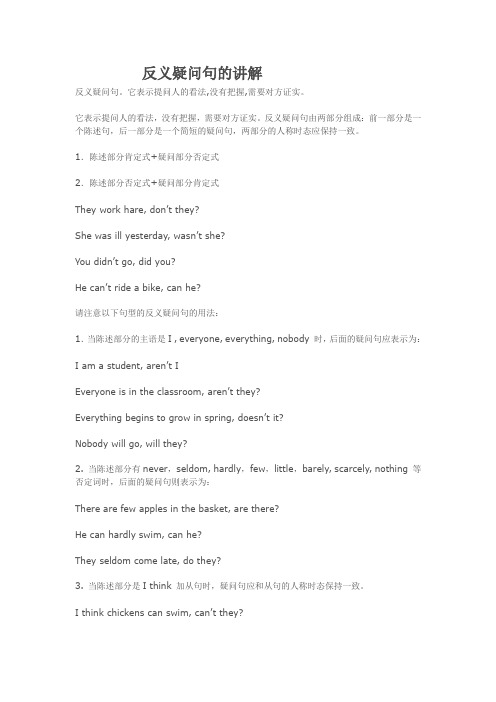
反义疑问句的讲解反义疑问句。
它表示提问人的看法,没有把握,需要对方证实。
它表示提问人的看法,没有把握,需要对方证实。
反义疑问句由两部分组成:前一部分是一个陈述句,后一部分是一个简短的疑问句,两部分的人称时态应保持一致。
1.陈述部分肯定式+疑问部分否定式2.陈述部分否定式+疑问部分肯定式They work hare, don’t they?She was ill yesterday, wasn’t she?You didn’t go, did you?He can’t ride a bike, can he?请注意以下句型的反义疑问句的用法:1.当陈述部分的主语是I , everyone, everything, nobody 时,后面的疑问句应表示为:I am a student, aren’t IEveryone is in the classroom, aren’t they?Everything begins to grow in spring, doesn’t it?Nobody will go, will they?2. 当陈述部分有never,seldom, hardly,few,little,barely, scarcely, nothing 等否定词时,后面的疑问句则表示为:There are few apples in the basket, are there?He can hardly swim, can he?They seldom come late, do they?3. 当陈述部分是I think 加从句时,疑问句应和从句的人称时态保持一致。
I think chick ens can swim, can’t they?I think Lucy is a good girl, isn’t she?I didn't think he was happy, was he?4. 陈述部分有had better 时,疑问句应用hadn’t开头:you’d better get up early, hadn’t you?5.当陈述部分是祈使句时,疑问句要根据语气来表达Let’s go out for a walk, shall we?Let us go our for a walk, will you?Turn on the radio, will you?6.反义疑问句的回答用yes,no,但是,当陈述部分是否定形式时,回答要按事实。
反义疑问句讲解

•6. 当陈述部分有never,seldom(很少), hardly(几乎不),few,little,nothing(没有) 等否定意义的词时,后面的反意疑问句则为肯 定形式
1.They have never visited his home, have they ?
2.There are few apples in the basket ,are there ?
let
当为”let us”时 当为”let’s”时
疑问句为“will you” 前五后四 疑问句为“shall we “ 前四后五
1.Let’s go to park, Shall we ?
前四
后五
2.Let us do homework. 前五
Will you ? 后四
回答
不管肯定否定,只抓信息点,是否吻合。如实回答
反义疑问句
Grammar: 反意疑问句
一、定义: 当我们陈述了一个事实,而又不是很有把握,就可以 在陈述句后加一个简短问句,称为反意疑问句。 例:
1. She is a student, isn’t she? 2. We speak Chinese, don’t we?
二、结构:
结构一: 前肯,+ 后否 eg. She is a student, isn’t she? 结构二: 前否,+ 后肯 eg. She isn’t a student, is she?
3
4
5
找be动词,是is,则 后半句用isn’t
isn’t she ?
Be动词
1.It’s a nice day ,
Isn’t it ?
2.The Greens were at home last night ,
反义疑问句

Everything is ready, isn't it?都准备好了,是吗?Nothing was said, was it ? 什么也没说,对吗?Nothing can stop us ,can it? 没有什么能阻止我们,是吗?(6)当陈述部分以不定代词one作主语,疑问部分的主语在正式的场合用one,在非正式场合用you。
One can’t be too careful, can one(you)?怎么细心都不为过,你说呢?One should learn from others, shouldn’t one(you)?人要想别人学习,是吗?(7)当陈述部分是“there be+主语+其它”结构时,疑问部分要用“be(not)+there”结构。
There is a book on the desk, isn't there?桌子上有本书,是吗?There used to be a lot of coal mines in the south, didn't there?过去在南部有大量煤矿,不是吗?(8)当陈述部分的主语是“I don’t think (suppose, believe)+that从句”结构时,疑问部分的主语和谓语须和从句中的主语和谓语在人称和数上相一致,并且还要用肯定形式。
I don’t suppose anyone will volunteer, will they?我认为没人会自愿去做,是吗?I don't think you've heard of him before, have you?我想你从前没听说过他,是吗?I think it is your duty to stick to the fighting post at any time, isn't it? 我认为无论何时坚持你的战斗岗位都是你的责任,对不?I don't suppose you are serious, are you? 我想你不是认真的,是吗?注意:主句的主语不是第一人称时I是不存在这种情况。
反意疑问句 (解析版)
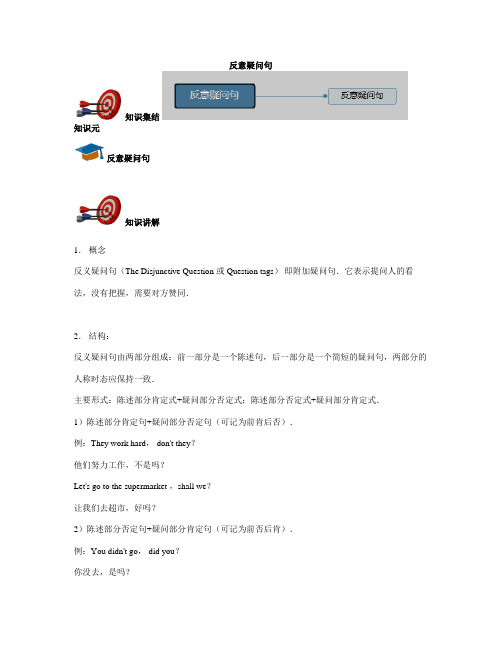
反意疑问句知识集结知识元反意疑问句知识讲解1.概念反义疑问句(The Disjunctive Question 或 Question tags)即附加疑问句.它表示提问人的看法,没有把握,需要对方赞同.2.结构:反义疑问句由两部分组成:前一部分是一个陈述句,后一部分是一个简短的疑问句,两部分的人称时态应保持一致.主要形式:陈述部分肯定式+疑问部分否定式;陈述部分否定式+疑问部分肯定式.1)陈述部分肯定句+疑问部分否定句(可记为前肯后否).例:They work hard, don't they?他们努力工作,不是吗?Let's go to the supermarket ,shall we?让我们去超市,好吗?2)陈述部分否定句+疑问部分肯定句(可记为前否后肯).例:You didn't go, did you?你没去,是吗?3.用法:1)反意疑问句的缩写问题当反意疑问句的附加部分为否定式时,习惯上只用缩写形式,不能分开来写.如:You love him very much, don't you?你很爱他,对不对?2)反意疑问句用于there be句式当陈述部分为there be句型时,附加部分仍用there be句式.如:There is a garden at the back of the house, isn't there?房子背后有一座花园,对吗?3)当 have 为助动词时,其反意疑问句沿用同样的助动词:He has already left, hasn't he?他已经离开了,是吗?4)当 have 为实意动词时,要分两种情况:①若表示"所有",反意疑问句可以用have,也可以用do:He has a lot of friends here, hasn't [doesn't] he?他在这儿有许多朋友,是吗?但是若陈述部分用的是have的否定式,反意疑问句用have 还是用do,取决于陈述部分的动词形式:He hasn't any money, has he?他没有钱,是吗?He doesn't have any money, does he?他没有钱,是吗?②若表示"吃"、"玩"等意思,反意疑问句要用do:He has supper at 5, doesn't he?他5点吃晚餐,是吗?He had a good time at the party, didn't he?他在晚会上玩得很开心,是吗?4)涉及情态动词的反意疑问句在通常情况下,当陈述部分含有情态动词时,反意疑问句会重复前面同样的情态动词.如:The boy can read and write, can't he?这男孩会读写,是吗?We shouldn't help him, should we?我们不应该帮助他,对吗?注意,当陈述部分含有情态动词must时,要分两种情况:若must表示"必须"或"有必要",则附加部分可用 mustn't 或needn't.如:You must leave at once, mustn't [needn't] you?他必须(有必要)马上离开,是吗?若must表示推测,意为"一定"时,其附加部分不能用must,而应根据must后的动词结构采用相应的动词形式.如:He must be tired, isn't he?他一定累了,是吗?He must have read it, hasn't [didn't] he?他一定读过它,是吗?He must have left yesterday, didn't he?他昨天一定走了,是吗?这三句中的must均表示推测,其意均表示"一定".第一句的must后为动词be,而句子为第三人称单数,所以附加部分用isn't he;第二句的must后为动词 read的完成式have read,表明动作已经发生过了,此时的附加部分既可与have保持一致使用hasn't he,也可与动词read何持一致使用didn't he;第三句的must后也是动词read的完成式,但由于它后面用了表示明确过去时间的状语,所以附加部分用didn't he,不用hasn't he.5)涉及祈使句的反意疑问句若陈述部分为祈使句,则其附加部分通常用will you, won't you, would you等.如:Come tomorrow, will you?明天来吧,好不好?Try it again, won't you?再试一次,好吗?但是,如果前面为否定的祈使句,则其附加问句部分要用肯定形式will you,而不能用否定式形式的won't.如:Don't tell him, will you?不要告诉他,好吗?注意,当祈使句Let's…或Let us…开头时,情况比较特殊﹣﹣由于Let's…总是表示建议,所以其后的附加部分总是用shall we.如:Let's have a break, shall we?我们休息一下吧,好不好?Let's meet on Monday, shall we?咱们星期一碰头吧,好不好?而祈使句以et us…时则有所不同,由于它有时表示请求,有时表示建议,所以要区别对待﹣﹣表示请求时,附加部分用will you;表示建议时,附加部分用shall we.如:Let us know your address, will you?请把你的地址告诉我们,好吗?Let us go swimming together, shall we?我们一起去游泳吧,好吗?4.易混淆点:1)反意疑问句的主语问题反意疑问句部分的主语应与陈述部分主语一致,且只能是代词,不能是名词.如:正:Jim likes English very much, doesn't he?吉姆很喜欢英语,对吗?如果陈述部分的主语是指示代词或不定代词等,在附加部分应改用相应的人称代词.如:That is a wallet, isn't it?这是个钱包,是吗?Nothing is serious, isn't it?一点也不严重,对吗?注意,如果陈述部分的主语为somebody, someone, everyone, everybody, no one, nobody 等指人的复合不定代词时,其附加部分的主语在正式文体中用he,在口语或非正式文体中通常用they.如:2)当陈述部分为否定式,反意疑问句为肯定式时,其回答往往与汉语不一致,需特别引起注意:"It isn't cheap, is it?" "Yes, it is." "它不便宜吧?""不,很便宜.""He doesn't love her, does he?" "No, he doesn't.""他不爱她,是吗?""是的,他不爱她." Nobody likes it, does he [don't they]?没有一个人喜欢它,是吗?5.解题方法点拨:回答反意疑问句的原则回答反意疑问句通常应根据实际情况来确定,如有人问你You are asleep, aren't you?你应回答No, I'm not.因为既然你能回答,肯定你还没有asleep.但如果别人问你 You aren't asleep, are you?(你还没有睡着,对吗),你也只能回答No, I'm not.(是的,还没有睡着),而不能回答为Yes, I'm not.也不能回答成 Yes, I am.6.高考命题方向:1)考查祈使句的反意疑问句Don't play football in the street, will you?不要在街上打篮球好吗?2)考查let's …的反意疑问句Let's go home together, shall we?我们一起回家好吗?3)考查陈述部分带有little, few, never, hardly, seldom等否定意义的词的反意疑问句He seldom takes a bus to school, does he?他很少乘公共汽车去学校,对吗?4)考查复合句的反意疑问句They said that you had finished your homework, didn't they?他们说你做完作业了,是吗?例题精讲反意疑问句例1.【答案】A【解析】题干解析:A 句中有never表示否定意义,排除BD.never后面是动词原形,可以推断本句是祈使句,祈使句的反义疑问句一般用will you。
反义疑问句讲解

反义疑问句反义疑问句(The Disjunctive Question) 即附加疑问句。
它表示提问人的看法,没有把握,需要对方证实。
反义疑问句由两部分组成:前一部分是一个陈述句,后一部分是一个简短的疑问句,两部分的人称时态应保持一致。
句型解释1.陈述部分肯定式+疑问部分否定式可记为前肯后否定.2.陈述部分否定式+疑问部分肯定式可记为前否后肯定.They work hard, don’t they?句子类型:一种是反义的附加疑问句,一种是非反义的附加疑速记方法前肯后否,前否后肯,前be后be,前无be后助,时态一致。
主语一般词语附加疑问句中主语用和主句一致的主语,用主格。
附加疑问句随从句。
不定代词当陈述部分的主语时( 1 )用one时,后面的疑问句可用one/he.(2)everything,anything,nothing,something时,附加疑问句中主语用it 不用they(3)this,that,或those,these时,附加疑问句中主语用it或they.(4)everyone,everybody,someone,somebody,anyone,nobody等,附加疑问句中主语一般用he(书面语)/they(口头语).(5)不定式,动名词,其他短语,附加疑问句中主语一般用it。
(6)在there be句型中,附加疑问句中主语一般用be/情态动词/助动词+there。
特殊句型否定意义的词否定意义的词(1)当陈述部分有never,seldom, hardly,few,little,barely, scarcely, nothing,none,rarely等否定意义的词汇时,后面的反意疑问句则为肯定形式:There are few apples in the basket, are there?He can hardly swim, can he?They seldom come late, do they?(2)当陈述部分含有否定意思的词是unhappy,dislike,unfriendly,nothing等含有否定词缀的派生词,也就是有un,dis,no-前缀、less-后缀等含有词缀而意思否定的词,当做肯定句处理,疑问部分要用否定形式。
(完整版)反义疑问句讲解及答案

反义疑问句一.句型解释反义疑问句(The Disjunctive Question):即附加疑问句。
它表示提问人的看法,没有把握,需要对方证实。
反义疑问句由两部分组成:前一部分是一个陈述句,后一部分是一个简短的疑问句,两部分的人称时态应保持一致。
1.陈述部分肯定式+疑问部分否定式2.陈述部分否定式+疑问部分肯定式She was ill yesterday, wasn’t she?You didn’t go, did you?二.特殊的句型1.祈使句。
祈使句后一般加上will you或won't you构成反意疑问句,用will you 多表示“请求”,用won't you 多表示提醒对方注意。
例如:Let引导的祈使句有两种情况:1) Let's...,后的反意疑问句用shall we或shan't we。
例如:Let's go home, shall we/ shan't we? 回家吧,好吗?2)Let us/me...后的反意疑问句用will you或won't you。
例如:Let me have a try, will you/won't you?3)祈使句都用will you 或won’t you2.当陈述部分含I think (believe, suppose...)that... 结构时,其反意疑问句须与从句的主、谓语保持一致,注意主句的主语必须是第一人称。
例如:I don't think he will come, will he?若是非第一人称,则与主句的主语相一致He thinks that she will come, doesn’t he?反意疑问句的陈述部分为I(We) don’t think(believe, suppose, consider)+ that从句时,从句为否定意义,问句部分的动词和主语仍与that从句保持一致且用肯定式。
高考英语反意疑问句讲解及练习
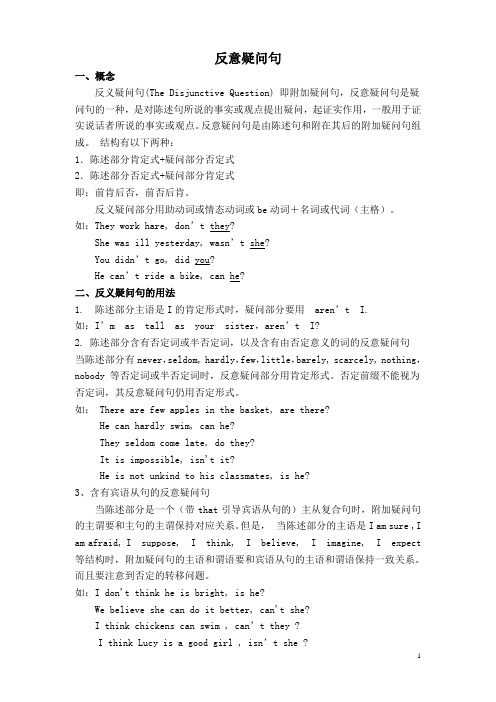
反意疑问句一、概念反义疑问句(The Disjunctive Question) 即附加疑问句,反意疑问句是疑问句的一种,是对陈述句所说的事实或观点提出疑问,起证实作用,一般用于证实说话者所说的事实或观点。
反意疑问句是由陈述句和附在其后的附加疑问句组成。
结构有以下两种:1.陈述部分肯定式+疑问部分否定式2.陈述部分否定式+疑问部分肯定式即:前肯后否,前否后肯。
反义疑问部分用助动词或情态动词或be动词+名词或代词(主格)。
如:They work hare, don’t they?Sh e was ill yesterday, wasn’t she?You didn’t go, did you?He can’t ride a bike, can he?二、反义疑问句的用法1. 陈述部分主语是I的肯定形式时,疑问部分要用aren’t I.如:I’m as tall as your sister,aren’t I?2. 陈述部分含有否定词或半否定词,以及含有由否定意义的词的反意疑问句当陈述部分有never,seldom, hardly,few,little,barely, scarcely, nothing,nobody 等否定词或半否定词时,反意疑问部分用肯定形式。
否定前缀不能视为否定词,其反意疑问句仍用否定形式。
如: There are few apples in the basket, are there?He can hardly swim, can he?They seldom come late, do they?It is impossible, isn't it?He is not unkind to his classmates, is he?3、含有宾语从句的反意疑问句当陈述部分是一个(带that引导宾语从句的)主从复合句时,附加疑问句的主谓要和主句的主谓保持对应关系。
但是,当陈述部分的主语是I am sure ,I am afraid, I suppose, I think, I believe, I imagine, I expect 等结构时,附加疑问句的主语和谓语要和宾语从句的主语和谓语保持一致关系。
反义疑问句讲解和练习答案
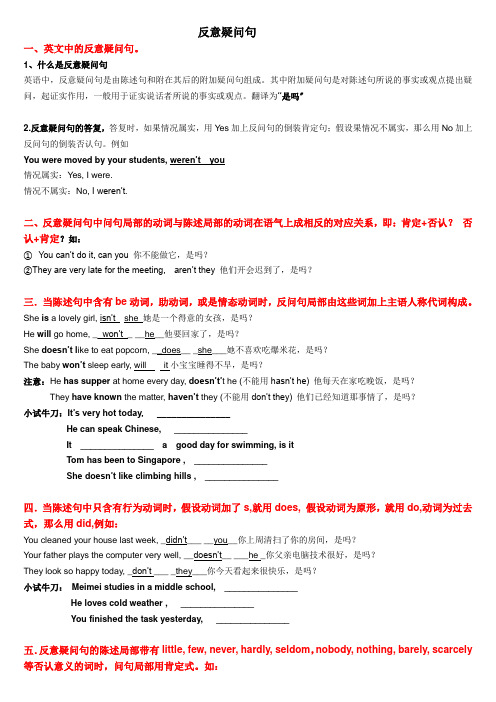
反意疑问句一、英文中的反意疑问句。
1、什么是反意疑问句英语中,反意疑问句是由陈述句和附在其后的附加疑问句组成。
其中附加疑问句是对陈述句所说的事实或观点提出疑问,起证实作用,一般用于证实说话者所说的事实或观点。
翻译为“是吗〞2.反意疑问句的答复,答复时,如果情况属实,用Yes加上反问句的倒装肯定句;假设果情况不属实,那么用No加上反问句的倒装否认句。
例如You were moved by your students, weren’t you情况属实:Yes, I were.情况不属实:No, I weren’t.二、反意疑问句中问句局部的动词与陈述局部的动词在语气上成相反的对应关系,即:肯定+否认?否认+肯定?如:①You can’t do it, can you 你不能做它,是吗?②They are very late for the meeting, aren’t they 他们开会迟到了,是吗?三.当陈述句中含有be动词,助动词,或是情态动词时,反问句局部由这些词加上主语人称代词构成。
She is a lovely girl, isn’t she 她是一个得意的女孩,是吗?He will go home, __won’t__ __he__他要回家了,是吗?She doesn’t l ike to eat popcorn, __does__ _she___她不喜欢吃爆米花,是吗?The baby won’t sleep early, will it小宝宝睡得不早,是吗?注意:He has supper at home every day,doesn’t’t he (不能用hasn’t he) 他每天在家吃晚饭,是吗?They have known the matter, haven’t they (不能用don’t they) 他们已经知道那事情了,是吗?小试牛刀:It’s very hot today, _______________He can speak Chinese, _______________It _______________ a good day for swimming, is itTom has been to Singapore , _______________She doesn’t like cl imbing hills , _______________四.当陈述句中只含有行为动词时,假设动词加了s,就用does, 假设动词为原形,就用do,动词为过去式,那么用did,例如:You cleaned your house last week, _didn’t___ __you__你上周清扫了你的房间,是吗?Your father plays the computer very well, __doesn’t__ ___he _你父亲电脑技术很好,是吗?They look so happy today, _don’t ___ _they___你今天看起来很快乐,是吗?小试牛刀:Meimei studies in a middle school, _______________He loves cold weather , _______________You finished the task yesterday, _______________五.反意疑问句的陈述局部带有little, few, never, hardly, seldom,nobody, nothing, barely, scarcely 等否认意义的词时,问句局部用肯定式。
英语反义疑问句最全解析

反义疑问句1)“am I”的否定形式是“aren’t I”,而不是“am not I”或“amn’t I”。
例如:I am right, aren’t I?2)everything和nothing作为陈述句的主语时是单数,因此反意疑问句中的主语要用“it”。
注意,nothing作为主语时,反意疑问句中的动词要用肯定形式。
例如:Nothing is wrong, is it?3)陈述句中的主语为everyone, everybody, anyone, nobody或no one时,反意疑问句中的主语用they。
注意,nobody和no one是否定词,因此反意疑问句应该用肯定的。
例如:Nobody knows it, do they?4)如果陈述句部分有no, never, hardly, scarcely, rarely, seldom等词,那么,陈述句本身就是否定的,所以要接一个肯定的反意疑问句。
例如:He has never been there, has he?5)如果陈述句中的动词是“wish”,那么反意疑问句中要用“may”。
例如:I wish to go there with you, may I?6)包括听话人在内时“let’s”的反意疑问句要用“shall we”。
反之,反意疑问句中要用“will you”。
例如:Let’s go, shall we?Let us go, will you?全真模拟试题1. All of the plants now farmed on a large scale were developed from plants ____ wild.A. that once growB. once they growC. they once grewD. once grew2. By the time you graduate, we ____ in Australia for one year.A. will be stayingB. will have stayedC. would have stayedD. have stayed3. He appreciated ____ the chance to deliver his thesis in the annual symposium on Comparative Literature.A. having givenB. to have been givenC. to have givenD. having been given4. The government official can hardly find sufficient grounds ____his arguments in favor of the revision of the tax law.A. on which to baseB. which to be based onC. to base on whichD. on which to be based5. Living in the desert involves a lot of problems, ____water shortage is the worst.A. not to mentionB. of whichC. let aloneD. for what6. Hydrogen is one of the most important element in the universe ____ it provides the building blocks from which the other elementsare produced.A.so thatB. but thatC. provided thatD. in that7. Just as relaxation is an important part of our lives, ____stress.A.so isB. as it isC. and so isD. the same is8. Victor took a bus and headed for home, ____ if his wife would have him back.A. not to knowB. not knownC. not knowingD. not having known9. We can make an exception ____.A. in any case of JohnB. in case of JohnC. in case of John’sD. in the case of John10. When the Cultural Revolution was launched in China, his father ______ college.A. attendedB. had been attendingC. was attendingD. has been attending11. My cat is a fussy eater, but my dog is so ____ that she’ll swallow down anything that is put in front of her.A. indiscriminateB. choosyC. indefiniteD. picky12. “This house is more ____than the federal government!” Mac complained to his parents. “You have rules for everything.”A. systematicB. democraticC. bureaucraticD. public试题答案与解析1. A)【句意】大规模种植的农作物都繁衍于野生植物。
- 1、下载文档前请自行甄别文档内容的完整性,平台不提供额外的编辑、内容补充、找答案等附加服务。
- 2、"仅部分预览"的文档,不可在线预览部分如存在完整性等问题,可反馈申请退款(可完整预览的文档不适用该条件!)。
- 3、如文档侵犯您的权益,请联系客服反馈,我们会尽快为您处理(人工客服工作时间:9:00-18:30)。
反意疑问句
一、反意疑问句的概念及构成
反意疑问句又叫附加疑问句,它表示提问者有一定的主见,但没有把握,希望对方证实一下。
反意疑问句由两部分组成,前一部分是对事物的陈述,后一部分是简短的提问。
反意疑问句的结构可分为两种:
A:肯定,否定?B:否定,肯定?
It is a fine day, isn’t it? It isn’t a fine day, is it?
二、反意疑问句的解答步骤
1.判定(判断该用肯定还是否定);
2.找动(找句子的助动词:按原形do,单三does,过去时态did加);
3.换代(将主语换为代词);
4.完成(写上问号,注意语调)。
I have been waiting for you, haven’t I?
Their parents have gone to London, haven’t they?
Jack wasn’t playing soccer, was he?
You have a good friend, don’t you?
We had a meeting, didn’t we?
三、特殊形式反意疑问句,除了要采取上述其中的几步外,还要注意其不规则变化。
1、特殊代词做主语
a、人称代词I作主语。
由于“am+not”无缩写形式,所以后面问句的谓语和陈述句的谓语不一致如:
I am a worker, aren’t I?
b、指示代词this或that; these或those作陈述句的主语, 其简短的主语分别为it或they。
如:This (That) is your pen, isn’t it?
These (those) aren’t books, are they?
c、不定代词:everyone, everybody , anyone, anybody, someone,somebody, no one, nobody,
问句部分的主语用they
如:Everyone studies English, don’t they?
Nobody is here, are they ?
d、不定代词 everything , nothing , anything , something 做主语时,其问句部分的主语用it .
如:Everything is here, isn’t it?
Nothing is here, is it?
2、祈使句后的反意疑问句形式
a、Let’s表示说话人向对方提出建议,简短问句的主语用 we表示,问句用 shall we?
如: Let’s have a cup of tea, shall we?
b、Let me或 Let us表示听话人提出请求,问句用 will you 。
如: Let me have a rest, will you?
c、其它的祈使句后可以加一个简短问句will you,使语气变得客气一些。
如:Have a rest, will you?
Don’t stand up, will you?
3、主从复合句的反意疑问句形式
a、一般主从复合句,疑问部分中的动词和代词应和主句中的动词和主语保持一致。
She says her brother is a worker, doesn’t she?
b、如果主从复合句中主句的主语I,谓语动词为think, expect , believe , imagine 等,问句中
的主语和谓语必须和从句中的主语,谓语保持一致。
如:I don’t think you have done it, have you?
I suppose you know the meaning of the word, don’t you?
We believe she can do it better, can't she?
4、含有下列情态动词时构成的反意疑问句形式
a、陈述句有had better时,问句中用had (hadn’t) 。
You’d better go home now, hadn’t you?
b、陈述句中有 must表示“必须”时问句用 needn’t或 mustn’t
You must do your homework, mustn’t you?/ needn’t you?
We mustn’t go home, must (need) we?
c、must表示“推测”时,问句中则不能用情态动词,而需要用其它形式。
如:She must be in the room, isn’t she?
You must have been to Shanghai, haven’t you?
4、陈述句中含有否定含义的词。
如no, nothing, nobody, little, few, never, neither, hardly, seldom 等, 问句部分应用肯定形式。
He never wanted to go, did he ?
I had few apples, did I?
There was nothing in the water, was there?
5. 陈述句部分中含有表示否定意义的前缀或后缀(如:un-, in-, im-, dis-, -less等)的词时,
否定前缀或后缀不能视为否定词,其反意疑问句仍用否定形式。
例如:
They dislike English, don't they? 他们不喜欢英语,不是吗?
That's unfair, isn't it? 那件事不公平,不是吗?
You are too careless, aren't you? 你太粗心了,不是吗?
6、并列句的反意疑问句,问句的主语一般与最近的句子的主语保持一致。
如:We must study English hard, or we aren’t good at English, are we?
It is late now, but he goes on doing his homework, doesn't he?
7、感叹句的反意问句形式。
感叹句的问句中的谓语动词要用否定形式,be动词要用一般现在时形式。
如:How slowly he runs, doesn’t he?
What a good worker he is, isn’t he?
8. 在there be 句型中,疑问句部分用 be (not) there 如:
There is a book on the table, isn’t there
9. 陈述句部分是"I wish…"句型时,附加问句部分用may I。
例如:
I wish I were you, may I? 我希望我是你,可以吗?
I wish her to come here, may I? 我希望她到这儿来,可以吗?
四、对反意疑问句的回答,
不管问题的提法如何,若事实是肯定的,就要用Yes,事实是否定的,就要用No。
回答反意疑问句要遵循“实事求是”的原则,肯定的答案就yes+肯定结构;否定的答案就用
no+否定结构。
答案要和实际情况相符这和汉语不一样,应特别注意。
如:
--You are not going out today, are you?
--No, I am not 是的,我今天不出去。
--Yes, I am. 不,我今天要出去。
